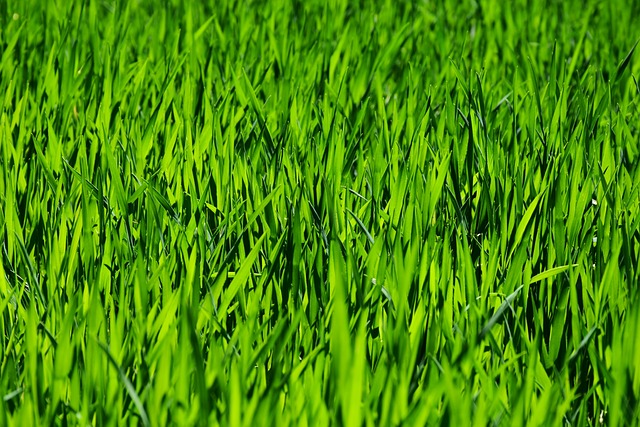Lawn Care and Landscaping are integral to creating a visually appealing and healthy outdoor space. A well-maintained lawn not only adds charm but also complements garden features and serves as a soothing backdrop. Key strategies for optimal lawn maintenance include selecting grass species that thrive in local climate and soil conditions, enhancing soil fertility to support lush growth, and implementing efficient irrigation systems to conserve water. Mowing at the correct height helps deter weeds and pests, while aeration and overseeding address compacted soils and introduce new grass varieties, making the lawn more durable. Environmentally friendly pest control and sustainable landscaping practices are essential for maintaining a healthy lawn that is both ecologically responsible and visually pleasing. Soil preparation, with a pH balance of 6.0 to 7.0 and an optimal mix of sand, silt, and clay, is crucial for promoting a healthy turf. The integration of organic matter enriches the soil and supports biological activity. For cool-season regions, grasses like Kentucky bluegrass and fescues are recommended, while warm-season climates favor Bermuda grass and Zoysia due to their drought tolerance. Proper maintenance practices tailored to regional ecological factors ensure a sustainable and resilient lawn that enhances both the landscape and the environment.
Embarking on a landscaping project or refining an existing design, homeowners and garden enthusiasts alike seek to blend form and function for a picturesque and sustainable outdoor space. This article delves into the art of landscaping design and implementation, focusing on key principles that elevate lawn care from mere maintenance to a pivotal component of your landscape’s visual appeal and ecological harmony. From selecting the ideal grass varieties to integrating innovative hardscapes and softscapes, this guide will illuminate how to create a lush, resilient lawn and a harmonious outdoor environment that thrives throughout the seasons. Additionally, we’ll explore sustainable practices and cutting-edge innovations that ensure your landscaping design not only impresses but also protects the planet. Join us as we navigate the essentials of lawn care within landscape design, from organic approaches to advanced technological solutions, ensuring every blade of grass and every plant plays a role in crafting an outdoor sanctuary that’s both beautiful and beneficial.
- Essential Principles of Effective Lawn Care in Landscape Design
- 1. Soil Preparation for a Healthy Lawn
- 2. Choosing the Right Grass Varieties for Your Climate and Soil Type
Essential Principles of Effective Lawn Care in Landscape Design

Effective lawn care within landscape design is a symbiotic endeavor that enhances both aesthetic appeal and turf health. A well-maintained lawn serves as a tranquil canvas within a diverse landscape, offering a visual respite amidst varying textures and colors of garden elements. Key principles in lawn care for landscape designs include understanding the grass species suitable for local soil and climate conditions, promoting soil health through regular fertilization, and employing appropriate irrigation systems to maintain optimal moisture levels without waste. Consistent mowing at the right height aids in preventing weed encroachment and encourages dense turf growth, which can outcompete weeds and pests. Aeration and overseeding practices are crucial for soil compaction alleviation and for introducing new grass varieties to strengthen the lawn’s resilience. Additionally, integrating eco-friendly pest management and adopting sustainable landscaping practices not only ensure a lush, green lawn but also protect the environment. Implementing these principles requires attention to detail, adaptability to seasonal changes, and a commitment to ongoing learning about advanced lawn care techniques and innovative landscaping design trends.
1. Soil Preparation for a Healthy Lawn

When embarking on a landscaping project that includes lawn care, soil preparation is a fundamental step in ensuring the health and longevity of your turf. A robust foundation is key; this means assessing and amending the soil’s composition to provide the optimal balance of nutrients and texture for grass growth. Begin by testing the soil’s pH level, as most lawn grasses thrive in slightly acidic to neutral conditions, with a pH between 6.0 and 7.0 being ideal. Adjusting the pH can involve adding lime to raise the pH or sulfur to lower it, depending on what’s necessary for your specific soil type.
Once the pH is within the desired range, attention should be turned to the soil texture and its composition of sand, silt, and clay. A balanced mix allows for proper aeration and drainage while retaining enough moisture. Organic matter, such as compost or aged manure, can improve soil structure by increasing its ability to retain nutrients and moisture. This process also enhances the soil’s biological activity, which is crucial for breaking down organic material into humus that further enriches the soil. Effective lawn care involves a thoughtful approach to soil preparation, laying the groundwork for a lush, vibrant lawn that withstands the test of time and environmental challenges. By investing time in proper soil preparation, landscapers can create a resilient foundation for a healthy lawn, ensuring that subsequent steps in lawn care, such as seeding, fertilization, and irrigation, are more effective and yield better results.
2. Choosing the Right Grass Varieties for Your Climate and Soil Type

When curating a lush, vibrant lawn within your landscaping design, selecting the appropriate grass varieties is paramount for success. Lawn Care and Landscaping practices dictate that the choice of grass should align with both regional climate conditions and local soil types to ensure longevity and low maintenance. For instance, cool-season grasses like Kentucky bluegrass and fescues thrive in areas with cold winters, experiencing frost and freezing temperatures, and require less water than their warm-season counterparts. Conversely, species such as Bermuda grass and Zoysia are well-suited to regions characterized by hot summers, as they exhibit drought tolerance and resilience in high-temperature environments.
Soil analysis is a crucial step in the lawn care process, as it informs the choice of grass varieties best adapted to your soil’s pH levels and nutrient content. Acidic soils may necessitate grass types like bluegrass or ryegrass, while alkaline soils might favor buffalograss or centipede grass. Additionally, clay-heavy or sandy soils will have different water retention properties, influencing the type of grass that will flourish. Engaging in regular lawn care and landscaping maintenance—such as aeration, proper fertilization, and targeted irrigation—ensures your chosen grass types can establish deep root systems and withstand environmental stressors. By adhering to Lawn Care and Landscaping best practices and selecting grass varieties that harmonize with the unique aspects of your environment, you’ll cultivate a lawn that is both aesthetically pleasing and ecologically sustainable.
Effective landscaping design hinges on a foundation of knowledgeable lawn care practices, ensuring a vibrant and sustainable outdoor space. By adhering to the essential principles outlined, such as meticulous soil preparation and selecting appropriate grass varieties for your specific climate and soil type, you can achieve a harmonious and thriving landscape. Implementing these strategies not only enhances the aesthetic appeal of your property but also fosters environmental health and sustainability. For those looking to refine their lawn care and landscaping efforts, understanding and applying these principles is key to success. Remember, a well-designed landscape is a living canvas that evolves with attentive care, reflecting the dedication and vision of its steward.
